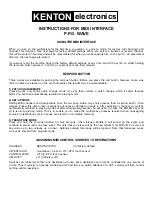
ARTURIA – ARP 2600 V – USER MANUAL
6
1
INTRODUCTION
Arturia would like to thank you for purchasing our synthesizer model: the ARP 2600
V. We are confident it will prove to be an extremely valuable addition to your music
production studio. If you’ve purchased our products before, you know we pride
ourselves in faithfully recreating the sound and feel of the original instruments, down
to the smallest detail. ARP 2600 V is no exception to this rule.
And if this is the first of our products you have owned, you are in for a treat! The
synthesizer upon which this model is based was the absolute pinnacle of analog
synthesizer technology at the time, light-years ahead of the competition.
1.1
The birth of ARP Instruments and the ARP2600
Alan R. Pearlman, whose initials would form the name of ARP Instruments, became
interested in instruments for electronic music as early as 1948, when he was a
student at the Worcester Polytechnic Institute. This was a means for him to associate
his two passions: electronic music and the piano.
It was by commercializing the amplifier models for the NASA Gemini and Apollo
programs that he would start his career. Around 1968 he started seriously imagining
the possibility of building electronic instruments – after hearing a recording of
“Switched-on Bach,” according to legend.
In 1969, Alan R. Pearlman, David Friend and Lewis G. Pollock created ARP
Instruments (originally called Tonus Inc.). The company, based in Newton Highlands
(Massachusetts, USA), conceived electronic products, but also and above all else
a large modular synthesizer, the ARP 2500. The machine used a matrix which
connected the different sections of the synthesizer, instead of the traditional cables
found in its competitor’s modular system. The ARP 2500 found success in American
universities.
The growth of ARP instruments was fast and in 1972 the ARP 2600, probably the most
legendary of the entire range, was unveiled. This semi-modular synthesizer,
conceived with an educational goal, was to become hugely successful after a
shaky start. The ARP 2600 was notably used by Stevie Wonder, Joe Zawinul
(Weather Report), Tony Banks (Genesis), Jean-Michel Jarre, Herbie Hancock... ARP
was the market leader in synthesizers during the 70’s with around 40% of the market
share.
In ten years, three versions of the ARP 2600 were commercialized: The first version
was called “Blue meanie” because of its steely blue finish. The “blue meanie” was
quickly replaced by a second version, with a grey background finish and white silk
screening (1972). This was to be more popular. In 1978 ARP decided to change the
graphic chart for all of its machines: a black background color with orange silk
screening was introduced. The ARP2600 benefited from its third and last version.
Содержание ARP 2600V
Страница 1: ...ARTURIA ARP 2600 V USER MANUAL 1 USER MANUAL...
Страница 81: ...ARTURIA ARP 2600 V USER MANUAL 81...







































